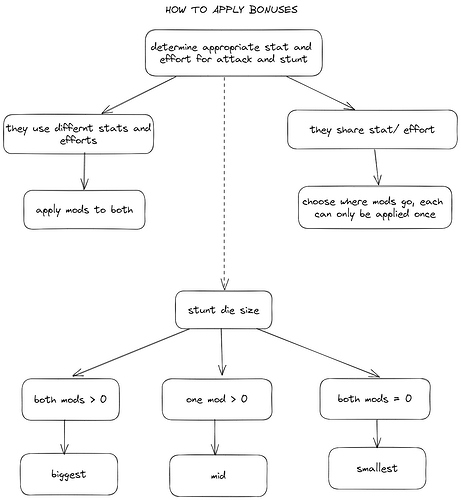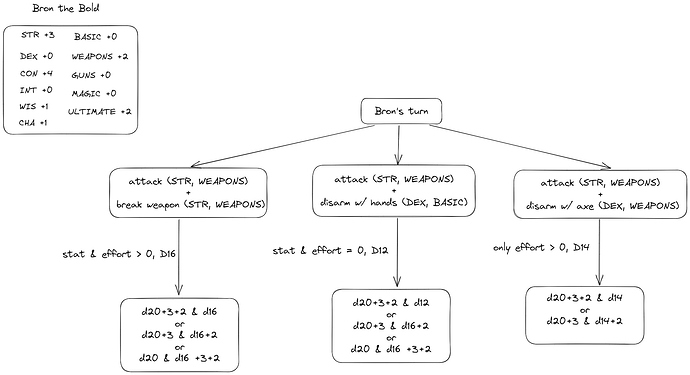Taking some inspiration from DCC’s Mighty Deeds of Arms, and my own quest to include multi-stat applications for single actions (and bearing out from my conversation here), I submit for consideration the Stunt Die.
The Stunt Die does not change how you normally resolve attempts in ICRPG, but it allows a PC to add an additional effect to your attempt related to a different stat. You do this by identifying which stat best reflects the effect you are seeking to achieve, and then rolling to beat the room TN with a lower die type - a D12, D14, or D16. Just like normal, when you beat the DC, the effect is successful. The point is that the stunt die is less likely to succeed than the standard check, and does not fumble or crit. I think it’s also advisable to make certain the stunt is never related to the same stat used for the attempt - because you don’t want a PC doubling down on the same high stat for bonus effects. So, let’s learn what I mean through some examples.
Brom the Bold is battling a brutal berserker with his battle axe. Brom is going to roll his STR to hit, as usual, but Brom also wants to attempt to disarm his opponent, so the GM rules Brom can do so with a DEX check on a D16. Brom’s player will roll the D20 and the D16 simultaneously, and may both hit and disarm the berserker, may only disarm him, or may only hit him.
Now, Brom had options here; he could have attempted an intimidating roar to intimidate his foe (CHA), tear off the Berserk’s bear skin by cutting the strap (WIS), or making him trip by maneuvering the berserker toward the slime covered flagstone (INT).
Snikt, the Gerblin hunter sees another warrior charging against Brom. Snikt looses her bow, rolling DEX to hit, but also wants to use the arrow to pin the warrior to the wall; she’ll have to beat the TN with a STR check, having to bring the bow to full draw to get the needed power. She may hit the warrior and anot pin him, or may miss the warrior, but still pin his cloak to the wall.
Could Snikt have shot the warrior’s helmet to spin it sideways, blinding him instead with an INT roll instead? Heck yeah!
Now Barhgalost the Mad gets to go. Seeing a band a brigands barging toward the part from an adjacent corridor, and lacking magics which might affect multiple targets, he conjures a magical missile, rolling INT to cast, and dispatch the nearest of those foes, but also wishes to deal out the bolt with such force, that it knocks the target back against his foes. Different tables may rule differently on this, but let’s say the exertion of additional energies is ruled to be a CON check. The missile could miss, but the force wave could still knock the target back, or it could whizz past them all - let the dice decide!
I think this is a simple way to encourage creativity at the table without adding a lot of mechanics, or even extra rolls. I don’t really know where the sweet spot for the different sized dice lies, so I didn’t really weigh in on that. It doesn’t necessarily need to be consistent; you may decide that the more powerful the effect, or the more targets the stunt die impacts, the lower the die type which should be rolled.
If you try this out at your table, please let me know how you did it, and how it played. WOOT!


